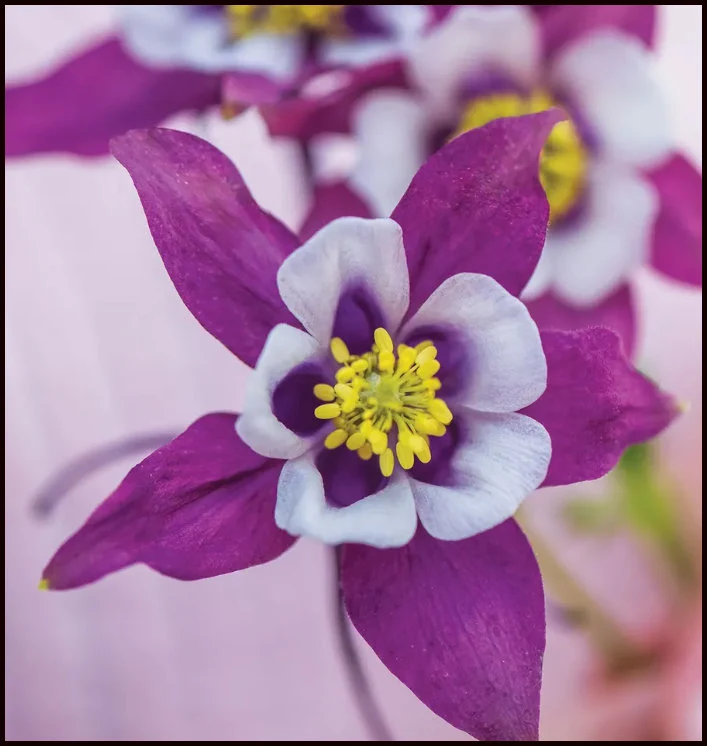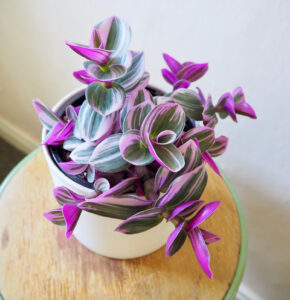Overview
- Botanical name: Aquilegia spp.
- Common name: Columbine
- Color: Purple and white bi-color blooms (many cultivars available)
- Bloom time: Mid to late spring, sometimes into early summer
- Plant type: Herbaceous perennial
- Height: 1 to 3 feet tall, depending on variety
- Zones: USDA 3–9 (varies slightly by cultivar)
- Light: Full sun to partial shade
- Soil: Well-drained, moderately rich soil
- Pollinators: Bees, hummingbirds, butterflies
Planting Purple and White Columbine
When to Plant
- Spring: After the last frost if starting from nursery transplants.
- Fall: For root establishment before winter.
- Seeds: Can be started indoors 6–8 weeks before last frost or direct sown in early spring/fall.
Where to Plant
- Sun: Full sun in cooler climates; partial shade in warmer areas.
- Soil: Rich in organic matter, moist but well-draining. Neutral to slightly acidic (pH 6.0–7.0).
Spacing
- Space plants 12–18 inches apart to allow air circulation and growth.
Growing and Caring for Columbine
Watering
- Keep soil evenly moist, especially in the first growing season.
- Once established, they are fairly drought-tolerant.
- Avoid overhead watering to prevent fungal disease.
Fertilizing
- Columbine generally doesn’t need much fertilizing.
- Add compost in spring or apply a balanced, slow-release fertilizer once in early spring.
Mulching
- Apply a 2-inch layer of mulch to retain moisture and suppress weeds.
- Leave a little space around the base of the plant to avoid crown rot.
Deadheading
- Remove spent flowers to promote more blooms and prevent aggressive self-seeding.
- If you want them to reseed naturally, leave a few flowers to go to seed.
Bloom Time and Flower Characteristics
- Flowers appear from late spring to early summer.
- They have unique, backward-pointing spurs that give them their fairy-like, starry appearance.
- The purple and white bicolor varieties often have deep violet outer petals with creamy white centers, creating a soft contrast.
- Blooms last several weeks and are excellent for cutting gardens.
Pruning and Maintenance
- Cut back flower stalks after blooming to encourage a second flush or tidy the plant.
- Trim back foliage in late summer if it becomes ragged or diseased.
- Columbines are short-lived perennials (often lasting 3–4 years), but they reseed readily to maintain a presence in your garden.
Propagation
By Seed
- Let some blooms go to seed in late summer.
- Collect seeds and scatter them in fall for natural cold stratification or refrigerate them for a few weeks before spring sowing.
By Division
- Columbines don’t like being disturbed, and division is not usually recommended. Reseeding is the best propagation method.
Pests and Problems
| Problem | Cause | Solution |
|---|---|---|
| Leaf miners | Larvae burrow into leaves | Remove affected leaves, use neem oil or insecticidal soap |
| Powdery mildew | High humidity, poor airflow | Thin surrounding plants, avoid overhead watering |
| Aphids | Sap-sucking pests | Spray with water or insecticidal soap |
| Crown/root rot | Poor drainage or overwatering | Plant in well-draining soil, avoid wet feet |
Columbines are otherwise relatively pest-free and not typically bothered by deer or rabbits.
Companion Plants
Columbines pair beautifully with:
- Hostas
- Ferns
- Bleeding heart (Dicentra)
- Lungwort (Pulmonaria)
- Brunnera
- Heuchera (Coral Bells)
These combos are especially great in woodland or cottage-style gardens where filtered light and layered textures create a magical effect.
Winter Care
- Columbine is cold hardy and usually survives winters without issue.
- After frost kills back the top growth, cut it down to a few inches above ground.
- Mulch lightly to protect the crown in very cold zones (3–4).
Fun Facts About Columbine
- The name Aquilegia comes from the Latin word aquila, meaning “eagle,” referring to the flower’s spurred petals that resemble an eagle’s talons.
- The flower is a traditional symbol of wisdom and strength.
- It’s also the state flower of Colorado.
- Many hybrids are bred specifically for their two-toned coloring—purple and white is a classic combo!
Varieties You Might Like
Here are some purple and white varieties or similar cultivars worth checking out:
- Aquilegia ‘Winky Double Purple-White’ – Double-flowered, compact, and very floriferous.
- Aquilegia vulgaris ‘William Guinness’ – Elegant bicolor with rich purple outer petals and white centers.
- Aquilegia ‘Songbird Blue’ – Though more lavender-blue than purple, it has a soft white contrast and large blooms.
Columbine in Floral Arrangements
- Columbines are gorgeous as cut flowers, though somewhat delicate.
- Cut them in the morning when blooms are fully open.
- Strip lower leaves and place in cool water immediately.
- They add a whimsical, cottage-garden charm to spring bouquets.
Quick Care Recap
| Care Task | Details |
|---|---|
| Light | Full sun to part shade |
| Water | Moderate; keep evenly moist |
| Soil | Well-drained, rich in organic matter |
| Fertilizer | Light feeding in spring |
| Bloom Time | Mid to late spring |
| Deadhead | Yes, to encourage rebloom and reduce reseeding |
| Winter Care | Mulch in cold zones; cut back dead foliage |
| Pests | Leaf miners, aphids, mildew (manageable) |


